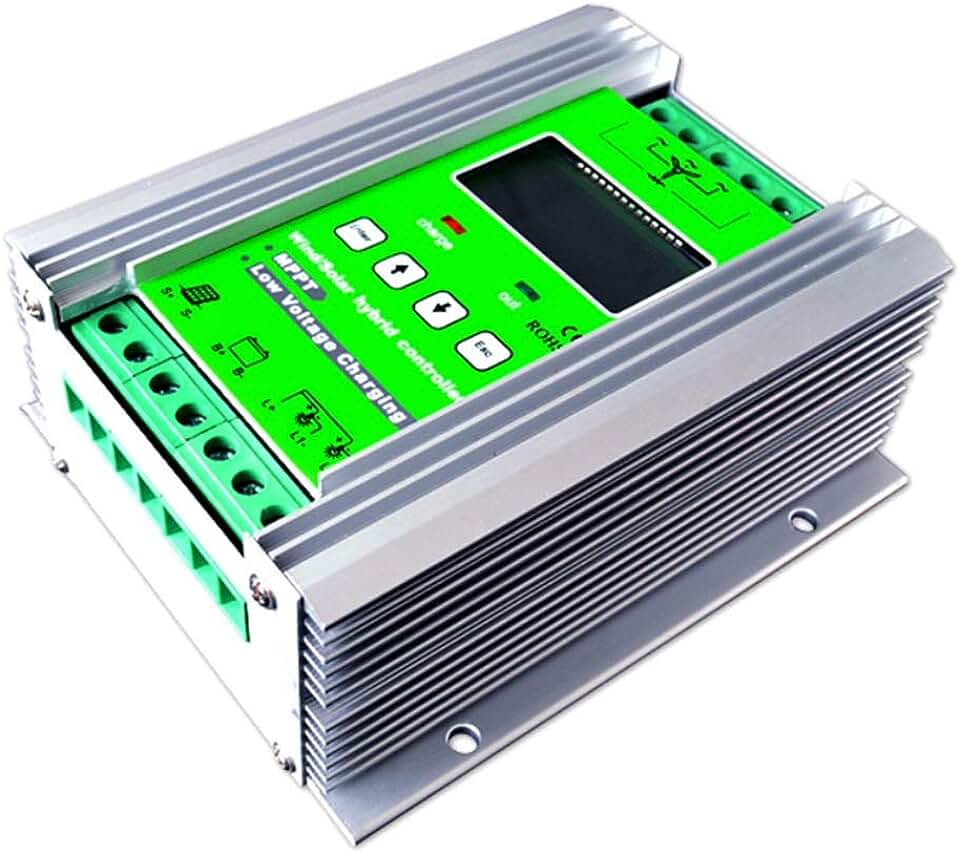Off-grid renewable energy systems are becoming increasingly popular as they provide a sustainable and independent source of power.
One critical component of such systems is the charge controller, which optimizes energy harvesting from sources like solar panels and wind turbines.
While traditional charge controllers have served their purpose well, advancements in technology have given rise to hybrid charge controllers that offer enhanced performance and optimization.
By leveraging a hybrid charge controller in an off-grid system, it is possible to optimize energy harvesting, minimize power losses, and ensure reliable and consistent power supply.
We will explore the benefits of using a hybrid charge controller for optimal energy harvesting in off-grid systems and discuss how they can be effectively integrated into such systems.
Maximum Power Point Tracking (MPPT)
A hybrid charge controller with MPPT technology can optimize energy harvesting by extracting the maximum power from both the solar panels and the wind turbine, ensuring that the energy yield is maximized.
MPPT allows a hybrid charge controller to optimize energy harvesting from both solar panels and a wind turbine, ensuring that the energy yield is maximized.
The technology works by continuously monitoring the power output of both the solar panels and the wind turbine, and adjusting the charging parameters in real-time to ensure that the maximum power is extracted from each energy source.
This results in a significant increase in overall energy production, as the system is able to capitalize on the strengths of each energy source.
For example, during periods of low wind speed, the system can rely on the solar panels to provide a steady stream of energy, while during periods of high wind speed, the system can take advantage of the wind turbine’s increased power output.
MPPT technology is an essential component of any hybrid renewable energy system, as it ensures that the system is operating at its full potential and delivering the highest possible energy yield.
Real-time Monitoring
The hybrid charge controller should have real-time monitoring capabilities to track the energy flows and adjust the system parameters accordingly, ensuring that the system is operating at its full potential.
Real-time monitoring is a critical feature of any hybrid charge controller, as it enables the system to track energy flows and adjust parameters in real-time to ensure optimal performance.
With real-time monitoring, the hybrid charge controller can continuously monitor the battery state of charge, the solar panel output, and the load current, and adjust the charging and discharging parameters accordingly.
This can help to prevent overcharging or undercharging of the batteries, optimize the use of solar energy, and minimize energy losses.
Real-time monitoring can detect any issues or anomalies in the system and alert the user, allowing for quick corrective action to be taken.
Overall, real-time monitoring is essential for ensuring that the hybrid charge controller operates at its full potential and provides reliable and efficient energy management.
Multi-Source Charging
The hybrid charge controller should be able to charge the battery bank from multiple sources, such as solar, wind, and/or grid power, to optimize the energy harvesting and reduce dependence on any single source.
Multi-Source Charging: The Hybrid Charge Controller’s Key to Optimized Energy Harvesting
The hybrid charge controller’s ability to charge the battery bank from multiple sources is a important feature for any off-grid energy system.
By leveraging multiple sources of energy, such as solar, wind, and grid power, the charge controller can optimize the energy harvesting process and reduce dependence on any single source.
This multi-source charging capability enables the system to function at its full potential, even during periods of limited sunlight or wind.
The hybrid charge controller can strategically blend the different sources of energy to ensure the battery bank is fully charged and ready to support the user’s energy needs.
For instance, during periods of abundant solar energy, the controller can prioritize solar charging to maximize the use of this clean and renewable energy source.
When the sun is not available, the controller can seamlessly switch to wind or grid power to keep the battery bank charged.
By leveraging multi-source charging, the hybrid energy system can provide a more reliable and resilient power supply, reducing the risks associated with dependence on a single energy source.
The system can also benefit from the strengths of each energy source, such as the consistency of grid power or the intermittent nature of solar and wind energy.
Dynamic Power Management
The charge controller should have dynamic power management capabilities to allocate power between the solar panels and the wind turbine based on real-time conditions, ensuring that the system is operating at its full potential.
Dynamic Power Management: The charge controller should have dynamic power management capabilities to allocate power between the solar panels and the wind turbine based on real-time conditions, ensuring that the system is operating at its full potential.
The charge controller should be able to continuously monitor the output of both the solar panels and the wind turbine, as well as the battery state of charge, and adjust the power allocation accordingly.
This will enable the system to optimize energy harvesting and minimize energy loss due to inefficiencies in the system.
For example, during periods of high wind speed, the charge controller can allocate more power to the wind turbine to maximize energy production.
Conversely, during periods of high solar irradiance, the charge controller can allocate more power to the solar panels to maximize their energy production.
By dynamically adjusting the power allocation based on real-time conditions, the system can achieve a higher overall energy yield and reduce the need for external power sources.
The dynamic power management system can also be equipped with advanced features such as predictive maintenance, automatic fault detection, and remote monitoring to ensure maximum system uptime and performance.
Battery Health Protection
The hybrid charge controller should have features to protect the battery bank from overcharging, undercharging, and deep discharging, to ensure the longevity of the batteries and the overall system.
The hybrid charge controller’s battery health protection features are important for ensuring the longevity of the batteries and the overall system.
Overcharging, undercharging, and deep discharging can all have negative effects on the battery bank, leading to reduced capacity, shorter lifespan, and even complete battery failure.
To prevent these issues, the hybrid charge controller should be equipped with advanced battery health protection features such as
* Overcharge protection: This feature prevents the battery from being overcharged, which can damage the battery cells and reduce their lifespan.
* Undercharge protection: This feature ensures that the battery is never allowed to fall below a certain threshold, which helps to prevent deep discharging and maintain the health of the battery.
* Deep discharge protection: This feature prevents the battery from being deep discharged, which can cause permanent damage to the battery cells and reduce their lifespan.
* Thermal management: This feature helps to prevent overheating of the battery, which can also damage the battery cells and reduce their lifespan.
By incorporating these battery health protection features into the hybrid charge controller, users can ensure that their battery bank is protected from harm and will last for many years to come.
This is especially important in off-grid solar power systems, where the battery bank is a critical component of the system and any damage to the batteries can have serious consequences.
Grid-Tie Compatibility
The charge controller should be compatible with grid-tie systems, allowing the system to sell excess energy back to the grid and maximize the energy harvesting potential.
Grid-Tie Compatibility: Unlocking the Full Potential of Your Solar Energy System
When it comes to maximizing the energy harvesting potential of your solar energy system, grid-tie compatibility is a important factor to consider.
A grid-tie compatible charge controller allows your system to sell excess energy back to the grid, making the most of your investment.
This feature ensures that your system operates at its full potential, providing you with a significant amount of clean and renewable energy.
In addition, a grid-tie compatible charge controller helps you to monitor your energy usage and production in real-time, giving you a better understanding of your system’s performance.
This allows you to make informed decisions about your energy usage and maximize the benefits of your solar energy system.
Moreover, a grid-tie compatible charge controller ensures that your system meets the safety and performance standards set by grid operators.
This gives you peace of mind, knowing that your system is safe and reliable.
Grid-tie compatibility is a critical feature to look for when selecting a charge controller for your solar energy system.
It allows you to sell excess energy back to the grid, provides real-time monitoring, and ensures that your system meets safety and performance standards.
By investing in a grid-tie compatible charge controller, you can maximize the energy harvesting potential of your solar energy system and enjoy a reliable and efficient clean energy source.
Communication Interfaces
The charge controller should have communication interfaces, such as RS232, RS485, and/or Ethernet, to allow for remote monitoring and control of the system, and enable advanced features such as smart metering and demand response.
When it comes to communication interfaces, a robust charge controller should be equipped with a variety of options to accommodate different monitoring and control needs.
RS232, RS485, and Ethernet are essential communication interfaces that enable remote monitoring and control of the system, allowing users to stay informed and in control, even when they are not physically present.
RS232 and RS485 interfaces offer reliable and secure communication over short distances, making them ideal for use in remote locations where Ethernet connectivity is not available.
These interfaces can be used to connect the charge controller to a variety of devices, including metering systems, remote display panels, and alarm systems.
On the other hand, Ethernet interfaces offer a high-speed, reliable, and flexible communication solution, allowing users to connect their charge controllers to the internet and access advanced features such as smart metering and demand response.
Ethernet interfaces also enable remote monitoring and control of the system, allowing users to stay informed and in control from anywhere in the world.
These interfaces allow users to stay informed and in control, even when they are not physically present, making them an essential component of any charging system.
Scalability and Flexibility
The hybrid charge controller should be scalable and flexible to accommodate different system configurations and energy sources, allowing for easy expansion and adaptation as energy needs evolve over time.
The hybrid charge controller should be designed with scalability and flexibility in mind, as it is essential to accommodate different system configurations and energy sources.
This allows for easy expansion and adaptation as energy needs evolve over time.
For example, a homeowner may start with a small solar panel system and later decide to add wind power or a battery bank to increase their energy independence and reduce their carbon footprint.
A flexible hybrid charge controller can accommodate these changes seamlessly, ensuring that the system operates optimally and efficiently.
Moreover, scalability is important for commercial and industrial applications, where energy demands can vary significantly and may require customized solutions.
With a scalable and flexible hybrid charge controller, users can easily integrate multiple energy sources, such as solar, wind, and hydroelectric power, and adjust the system’s parameters to match their specific energy requirements.
By prioritizing scalability and flexibility, the hybrid charge controller can provide long-term value and adaptability, ensuring that the off-grid energy system meets the users’ changing needs and energy demands over time.
Want More? Dive Deeper Here!
Hey there! If you’re the type who loves going down the rabbit hole of information (like we do), you’re in the right spot. We’ve pulled together some cool reads and resources that dive a bit deeper into the stuff we chat about on our site. Whether you’re just killing time or super into the topic, these picks might just be what you’re looking for. Happy reading!






